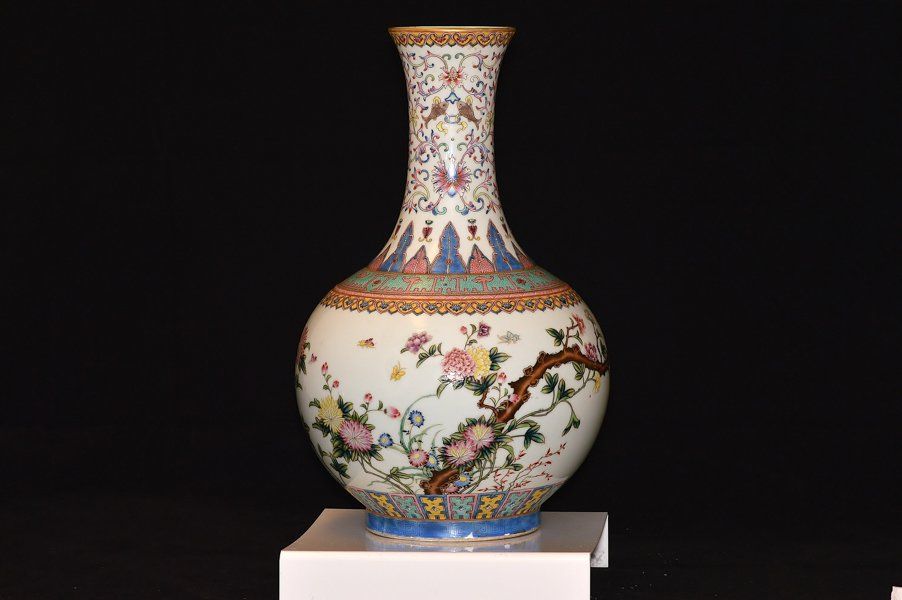Blog
Joseph.Sharon@chinesemasterpieces.com
Significantly Important Qianlong Imperial Marked and Period
Incised Mirror Black Glazed Bowl

This exceptionally refined Imperial Qianlong marked and period Mirror Black Glazed Bowl, dating from 1736 to 1795, features intricately incised architectural and landscape decorations, which are meticulously highlighted with gold. This piece represents the most outstanding example of its kind currently available on the open market. We encourage you to consult various auction catalogs and reference materials to identify any comparable black glazed items; it is likely you will find none that match this masterpiece. Each incised line is executed with remarkable precision, nearly as fine as a human hair. The true artistry of this bowl cannot be fully appreciated through photographs; it must be experienced in person to grasp the extraordinary skill and control required for its creation. The form of the bowl is exquisite, and one can observe the glaze delicately thinning at the rim, revealing the underlying white biscuit. Aspiring collectors should educate themselves on differentiating between quality pieces and exceptional masterpieces. A closer examination of many Qing Dynasty artifacts often reveals that they were crafted by less proficient artisans, resulting in a lack of balance, detail, and depth. Attention to detail, color balance, and shading is essential for appreciating these nuances. The Qianlong seal mark is aligned with the front of the bowl, a customary practice of the Qianlong period, which is widely acknowledged as the zenith of Chinese porcelain artistry. This bowl measures approximately 9 3/16 inches in diameter.
Groundbreaking Discovery Challenges the Established History of Ru Ware
[Cherry Hill NJ 05/25/2025] – A shocking revelation in the world of ancient Chinese ceramics is set to disrupt the established understanding of Ru ware, one of the most prized ceramics of the Song Dynasty. Independent researcher and collector [Joseph Sharon] has uncovered irrefutable evidence proving that Imperial Ru wares incorporated crushed blue agate in their glazes and fire-gilded bands on their rims and bases—features that have been systematically ignored by museums and auction houses.
With a personal collection of over 300 pieces and extensive microscopic imaging evidence, [Joseph Sharon] has repeatedly attempted to present these findings to leading institutions, only to be met with silence and resistance.
Microscopic Evidence Exposes Long-Held Myths
Through high-resolution microscopic analysis, the presence of blue agate within Ru ware glazes has been confirmed. This contradicts the long-held claim that no such material remained after firing or was used in Song Dynasty ceramics. Agate, with its unique melting properties, remains intact within the glaze, creating a distinctive and recognizable effect that is scientifically impossible to replicate artificially.
Furthermore, many of these artifacts feature fire-gilded bands, a lost technique using a gold and mercury mixture that corrodes naturally over time, forming cuprite and botryoidal malachite—a signature of genuine Imperial wares. This technique has not been in use since the mid-1800s due to safety concerns, further proving the age and authenticity of these artifacts.
Resistance from Museums and Auction Houses
Despite sharing detailed analyses and microscopic photographs, leading auction houses and institutions, including the Palace Museum in Taiwan, have refused to examine the collection. The implications of this research challenge the credibility of millions of dollars' worth of past Ru ware sales, many of which were misattributed merchant-grade wares.
"The art world must prioritize historical accuracy over institutional reputations and market interests," says [Joseph Sharon]. "Refusing to engage with this evidence is a disservice to scholarship and collectors alike."
Call to Action: Seeking Open-Minded Scholars and Institutions
[Joseph Sharon] invites independent researchers, universities, and institutions to examine the collection and conduct independent testing to validate these findings.
In an effort to bring transparency to the art and research world, a new website is set to launch, showcasing high-resolution microscopic images, detailed reports, and side-by-side comparisons with known Ru ware artifacts.
History must be shaped by evidence, not by the reluctance of institutions to admit past mistakes. The time for truth is now.
For media inquiries, interview requests, or collaboration opportunities, please contact:
[Joseph Sharon]
[E-MAIL
Joseph.Sharon@chinesemasterpieces.com]
WEBSITE [https://www.chinesemasterpieces.com]
[Joseph Sharon] is a dedicated independent researcher and collector specializing in Song Dynasty ceramics. With an extensive collection and a passion for uncovering historical truths, [Joseph Sharon] has spent years analyzing and documenting evidence that challenges conventional narratives. Through scientific analysis and meticulous research, their goal is to bring long-overdue transparency to the world of ancient Chinese ceramics.
Chinese Masterpieces

Qing Dynasty Vase Featuring Hundred Cranes, Accompanied by Qianlong Seal Mark and Period Designation












